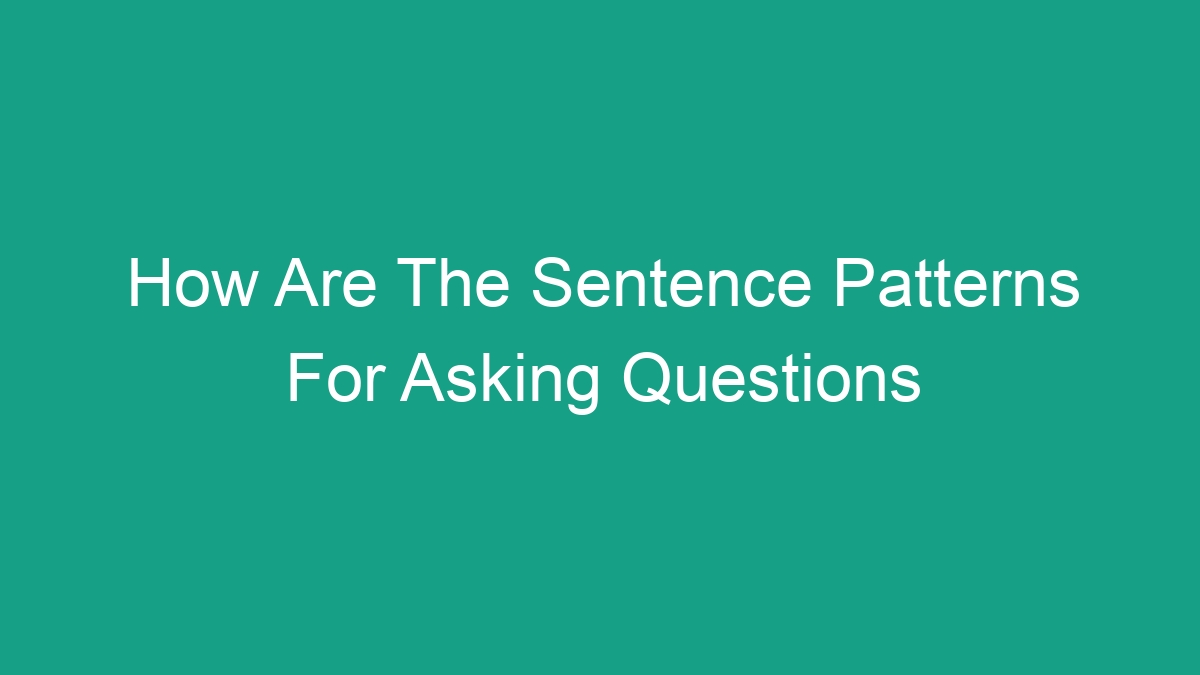
Asking questions is a fundamental aspect of communication. Whether you’re conducting an interview, seeking information, or engaging in casual conversation, knowing how to form effective questions is crucial. In this article, we’ll explore the different sentence patterns for asking questions and how to use them effectively.
The Types of Questions
Before we delve into sentence patterns, it’s important to understand the different types of questions. There are several types of questions, including:
- Yes/No Questions – These questions can be answered with a simple “yes” or “no”. For example, “Are you coming to the party?”
- Wh- Questions – These questions begin with “wh-” words such as “who”, “what”, “when”, “where”, “why”, and “how”. For example, “What time is the meeting?”
- Choice Questions – These questions present options for the respondent to choose from. For example, “Do you prefer tea or coffee?”
- Tag Questions – These questions are added to the end of a statement to elicit confirmation or agreement. For example, “You enjoyed the movie, didn’t you?”
Sentence Patterns for Asking Yes/No Questions
Yes/No questions are the simplest type of question. They require a straightforward answer of “yes” or “no”. The basic sentence pattern for asking a yes/no question is:
Auxiliary verb + subject + main verb
For example:
- Are you coming to the party?
- Is she going to the concert?
- Did they finish their homework?
In these examples, the auxiliary verbs “are”, “is”, and “did” are used to form the questions. It’s important to note that the auxiliary verb precedes the subject in yes/no questions.
Sentence Patterns for Asking Wh- Questions
Wh- questions are used to gather specific information and often begin with “who”, “what”, “when”, “where”, “why”, or “how”. The basic sentence pattern for asking a wh- question is:
Wh- word + auxiliary verb + subject + main verb
For example:
- What time is the meeting?
- Where are they going for vacation?
- Why did he leave early?
In these examples, the wh- words are used to introduce the questions, followed by the auxiliary verbs and subjects. This pattern helps to elicit specific information from the respondent.
Sentence Patterns for Asking Choice Questions
Choice questions offer options for the respondent to choose from. The sentence pattern for asking a choice question is:
Subject + auxiliary verb + main verb + option 1 + or + option 2
For example:
- Do you prefer tea or coffee?
- Are you going to the beach or the mountains for vacation?
In these examples, the subject is followed by the auxiliary verb and main verb, and then the options are presented using “or”. This pattern allows for easy selection between the presented choices.
Sentence Patterns for Asking Tag Questions
Tag questions are added to the end of a statement to elicit confirmation or agreement. The sentence pattern for asking a tag question is:
Statement + tag question
For example:
- You enjoyed the movie, didn’t you?
- She’s coming with us, isn’t she?
In these examples, the tag questions are added to the end of the statements to seek agreement or confirmation from the listener. The tag questions mirror the form of the statements, with a reversal of the statement’s main verb and the addition of the appropriate auxiliary verb.
Using Intonation for Asking Questions
Aside from understanding the sentence patterns for asking questions, it’s important to consider intonation. In English, rising intonation is used to indicate a question. This means that the pitch of the voice rises at the end of the question. For example, the sentence “You’re coming to the party” becomes a question when the intonation rises at the end: “You’re coming to the party?”
Additionally, intonation can convey different types of questions. A rising intonation typically indicates a yes/no question, while a falling-rising intonation indicates a wh- question or a choice question. Mastering intonation enhances the effectiveness of asking questions in conversation.
Tips for Asking Effective Questions
Asking effective questions is an art that can be honed with practice. Here are some tips for asking questions:
- Be Clear and Concise – Ensure that your questions are clear and to the point to avoid ambiguity.
- Use Appropriate Tone and Body Language – The way you ask a question, including your tone and body language, can impact how it’s received.
- Listen Attentively – Pay attention to the responses and follow up with additional questions if necessary.
- Avoid Leading Questions – Refrain from asking questions that lead the respondent to a particular answer.
- Respect Cultural Differences – Be mindful of cultural nuances when asking questions, especially in cross-cultural communication.
Practice Makes Perfect
Like any aspect of language, mastering the art of asking questions takes practice. Whether you’re in a professional setting or engaging in casual conversation, effective questioning can greatly enhance communication and understanding. With an understanding of the different sentence patterns and tips for asking questions, you can navigate various scenarios with confidence.
FAQs
What are the different types of questions?
The different types of questions include yes/no questions, wh- questions, choice questions, and tag questions.
Why is intonation important when asking questions?
Intonation is important because it signals to the listener that a question is being asked. It helps convey the intended meaning of the sentence.
How can I improve my questioning skills?
Improving your questioning skills can be achieved through practice, paying attention to intonation and tone, and being mindful of cultural differences.



